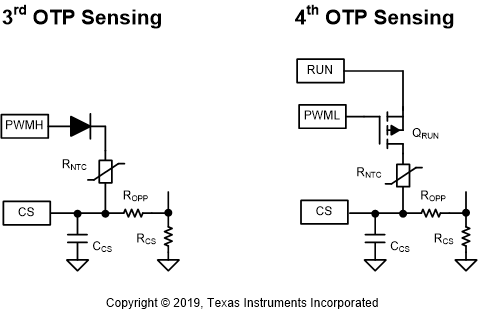JAJSMZ6 december 2021 UCC28781
PRODUCTION DATA
- 1
- 1 特長
- 2 アプリケーション
- 3 説明
- 4 Revision History
- 5 Pin Configuration and Functions
- 6 Specifications
-
7 Detailed Description
- 7.1 Overview
- 7.2 Functional Block Diagram
- 7.3
Detailed Pin Description
- 7.3.1 BUR Pin (Programmable Burst Mode)
- 7.3.2 FB Pin (Feedback Pin)
- 7.3.3 REF Pin (Internal 5-V Bias)
- 7.3.4 VDD Pin (Device Bias Supply)
- 7.3.5 P13 and SWS Pins
- 7.3.6 S13 Pin
- 7.3.7 IPC Pin (Intelligent Power Control Pin)
- 7.3.8 RUN Pin (Driver and Bias Source for Isolator)
- 7.3.9 PWMH and AGND Pins
- 7.3.10 PWML and PGND Pins
- 7.3.11 SET Pin
- 7.3.12 RTZ Pin (Sets Delay for Transition Time to Zero)
- 7.3.13 RDM Pin (Sets Synthesized Demagnetization Time for ZVS Tuning)
- 7.3.14 XCD Pin
- 7.3.15 CS, VS, and FLT Pins
- 7.4
Device Functional Modes
- 7.4.1 Adaptive ZVS Control with Auto-Tuning
- 7.4.2 Dead-Time Optimization
- 7.4.3 EMI Dither and Dither Fading Function
- 7.4.4 Control Law Across Entire Load Range
- 7.4.5 Adaptive Amplitude Modulation (AAM)
- 7.4.6 Adaptive Burst Mode (ABM)
- 7.4.7 Low Power Mode (LPM)
- 7.4.8 First Standby Power Mode (SBP1)
- 7.4.9 Second Standby Power Mode (SBP2)
- 7.4.10 Startup Sequence
- 7.4.11 Survival Mode of VDD (INT_STOP)
- 7.4.12
System Fault Protections
- 7.4.12.1 Brown-In and Brown-Out
- 7.4.12.2 Output Over-Voltage Protection (OVP)
- 7.4.12.3 入力過電圧保護 (IOVP)
- 7.4.12.4 FLT ピンの過熱保護 (OTP)
- 7.4.12.5 CS ピンの過熱保護 (OTP)
- 7.4.12.6 プログラム可能な過電力保護 (OPP)
- 7.4.12.7 ピーク電力制限 (PPL)
- 7.4.12.8 出力短絡保護 (SCP)
- 7.4.12.9 過電流保護 (OCP)
- 7.4.12.10 External Shutdown
- 7.4.12.11 Internal Thermal Shutdown
- 7.4.13 Pin Open/Short Protections
-
8 Application and Implementation
- 8.1 Application Information
- 8.2
Typical Application Circuit
- 8.2.1 Design Requirements for a 60-W, 15-V ZVSF Bias Supply Application with a DC Input
- 8.2.2 Detailed Design Procedure
- 8.2.3 Application Curves
- 9 Power Supply Recommendations
- 10Layout
- 11Device and Documentation Support
- 12Mechanical, Packaging, and Orderable Information
7.4.12.5 CS ピンの過熱保護 (OTP)
入力 OVP 検出に FLT ピンがすでに使用されている場合、UCC28781 では CS ピンで 3 番目と 4 番目の OTP 機能を使用できます。これら 2 つの構成は、CS ピンの電流検出信号と OPP レベルには影響しません。これら 2 つの検出回路は PWML がオフになった後でのみバイアスされるためです。2 つのアプリケーションの回路を、図 7-42 に示します。3 番目の OTP 構成では、PWMH ピンを High にプルすると、RNTC と ROPP が分割抵抗を形成し、温度に依存する電圧信号を CS ピン上に生み出します。この電圧が、2 サイクル連続で、消磁時間 (TDM) の終了前にサンプリングされる 1.2V のスレッショルドを超えると、OTP フォルトがトリガされます。OTP センシング回路は、PWML のオン時間の間は PWMH が Low にプルされるため、ピーク電流ループの動作に影響を与えません。1.5s の長いタイマが起動し、コントローラはスイッチングを行わずにフォルト状態を維持します。この長い回復時間により温度ヒステリシスが生まれ、次の VO 再起動試行の前にホット・スポットの温度が低下します。FLT ピンの最初の OTP 構成と比べて、この構成では AAM と ABM の両方で OTP を有効にできるため、約 25% の出力負荷でも OTP をトリガできます。
4 番目の構成は小信号 PMOS を使用するもので、広い出力負荷範囲に対応する最も包括的な方法です。RUN ピンを使用して検出回路にバイアスを印加し、PWML ピンによって PMOS ゲートを制御して、PWML が Low のときのみ検出が行われるようにします。
 図 7-42 CS ピンに OTP を実装するための 2 つの接続
図 7-42 CS ピンに OTP を実装するための 2 つの接続